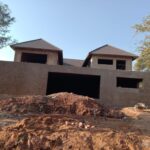Thatch is a layer of dead grass, roots, and other organic matter that accumulates on the surface of a lawn or grassy area. While some thatch is normal and can be beneficial, excessive thatch buildup can have several negative effects on your lawn and garden:
Reduced Water Infiltration: Thatch acts as a barrier that can inhibit water from penetrating the soil. This can lead to poor water absorption, resulting in water runoff, erosion, and drought stress for your grass.
Impaired Nutrient Uptake: Thick thatch can also hinder the uptake of essential nutrients by grass roots. This can lead to nutrient deficiencies and poor overall lawn health.
Increased Pest and Disease Risk: Thatch provides a sheltered environment for insects, pests, and disease organisms to thrive. This can lead to infestations and disease outbreaks that can harm your lawn.
Restricted Root Growth: Excessive thatch can limit the growth of grassroots, preventing them from reaching the deeper soil layers where they can access more water and nutrients. This can result in shallow-rooted grass that is more susceptible to stress.
Poor Air Circulation: Thatch can restrict air circulation near the soil surface, creating an environment conducive to fungal growth. Fungal diseases such as brown patches and snow mold can become more prevalent in thatchy lawns.
Uneven Surface: A thick thatch layer can create an uneven surface on your lawn, making it difficult to walk or mow. This can result in an unsightly and impractical lawn.
Reduced Aesthetic Appeal: A lawn with excessive thatch often looks brown and unhealthy. It may also feel spongy when walked on, which is not desirable for recreational purposes.
To address the negative effects of thatch, it’s important to regularly monitor your lawn and take steps to manage thatch buildup. This may include dethatching or aerating your lawn, adjusting your mowing and watering practices, and promoting healthy soil microbial activity to break down thatch naturally. Proper lawn care and maintenance can help you maintain a lush and healthy lawn while minimizing the negative effects of thatch. Thatch roofs have a unique and rustic appearance that adds character and charm to a building. Renovating a thatch roof can help preserve this traditional and attractive look.
Thatch roof renovation, like any construction or renovation project, has advantages and disadvantages. Thatch roofs are traditional roofs made from natural materials like straw, reed, or grass. Renovating or maintaining a thatch roof can be both rewarding and challenging, depending on various factors.
As a reputable stone-coated steel roofing system, the FIDDLER™ product represents a perfect blend of over 20 years of research and practical experience. Offering the ultimate in performance and engineering design is what FIDDLER™ roofing systems are all about.

